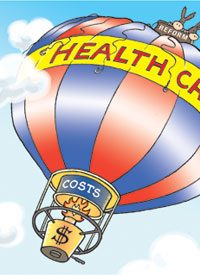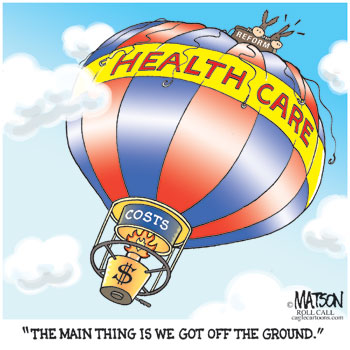
ITEM: The Associated Press reported on November 4: “In a coup for House Democrats, AARP will endorse sweeping health care overhaul legislation headed for a history-making floor vote…. Backing the 10-year, $1.2 trillion House bill is a tricky move for AARP. Many retirees are concerned about cuts in Medicare payments to medical providers, which will be used to finance an expansion of health insurance coverage to millions of working families.” That endorsement, of course, help supporters of comprehensive healthcare "reform"to get the legislation through the House.
ITEM: The Washington Post reported on November 4: “Democrats in Congress are embracing the spirit of President Obama’s call to slow the runaway rise of health-care costs but are shying away from some of the most aggressive techniques for achieving that.”
The Post cites a longtime left-wing activist as follows: “Ralph Neas, head of the nonpartisan National Coalition on Health Care, noted that ‘these bills do very little in terms of reining in long-term cost growth,” adding, “There is not enough in the public sector and virtually none in the private sector.’ … Only a few of the specific ideas … have been included in the legislation. ‘Voluntary efforts are never enough,’ Neas said. ‘There has to be some way to make it enforceable.’ ”
CORRECTION: The last thing free people need to do is to give the corruptible central government more power — that is, if they expect their freedom to last. George Washington assuredly recognized this fact, noting famously: “Government is not reason. It is not eloquence. Government is force; like fire, it is a dangerous servant — and a fearful master.”
Yet, this fall, the chief executive stood before a joint session of Congress and scolded the lawmakers and the public: Force all Americans to purchase health insurance. Otherwise, his plans to overhaul healthcare for the entire nation will not work.
This is just the beginning of the arm-twisting. The House Republican Conference, for instance, toted up no less than 111 agencies, boards, and committees created by the healthcare bill in its chamber. Speaker Nancy Pelosi nevertheless rammed it through the House by a narrow margin late on a Saturday night. Thus do lawmakers seize power over personal health decisions.
Indeed, the Joint Committee on Taxation has confirmed, as noted by Representative Dave Camp (R-Mich.), that Americans who fail to comply with the individual healthcare mandate — requiring the purchase of a policy estimated to cost $15,000 — face a potential five years in jail.
If you flip through the many pages of the House bill, remarked columnist David Harsanyi, “you will notice the word ‘regulation’ appears 181 times. ‘Tax’ is there 214 times. ‘Fees,’ 103 times. As we all know, nothing says ‘affordability’ like higher taxes and fees. The word ‘shall’ — as in ‘must’ or ‘required to’ — appears more than 3,000 times. The word, alas, never is preceded by the patriotic phrase ‘mind our own freaking business.’ Not once.”
The fact that AARP, a group that is almost reflexively leftist even when it is to the detriment of its supposed beneficiaries, bought into the House bill should be no surprise. While it is an activist group, AARP is much more: It stands to gain financially by the bill it touted. If the healthcare bill as written becomes law, it will drive potential competitors out of its own considerable insurance interests.
AARP does not sell insurance policies directly. It does, as noted by the Washington Post, lend its “name to plans in exchange for a tax-exempt cut of the premiums.” Critics did point out, as was reported by the Post, that AARP has a “thriving business in marketing branded Medigap policies, which provide supplemental coverage for standard Medicare plans available to the elderly. Democratic proposals to slash reimbursements for another program, called Medicare Advantage, are widely expected to drive up demand for private Medigap policies like the ones offered by AARP, according to health-care experts, legislative aides and documents.”
The financial gimmickry involved in disguising the ailments and flaws of the House healthcare bill would be rightly considered fraudulent if practiced in the private sector. The Wall Street Journal pulled few punches in its piece called “The Worst Bill Ever.” The Democrats in the House of Representatives, commented the Journal, supposedly “pay for” some six years of Speaker Pelosi’s legislation “with a decade of revenue, with the heaviest costs concentrated in the second five years. The House also pretends Medicare payments to doctors will be cut by 21.5% next year and deeper after that, ‘saving’ about $250 billion. ObamaCare will be lucky to cost under $2 trillion over 10 years; it will grow more after that.”
 Medicaid is to be expanded, while Medicare may be reduced, or so we are told. However, the only assured slashing will be to the private parts that are popular with seniors and effective. Says the Journal:
Medicaid is to be expanded, while Medicare may be reduced, or so we are told. However, the only assured slashing will be to the private parts that are popular with seniors and effective. Says the Journal:
All this is particularly reckless given the unfunded liabilities of Medicare — now north of $37 trillion over 75 years. Mrs. Pelosi wants to steal $426 billion from future Medicare spending to “pay for” universal coverage. While Medicare’s price controls on doctors and hospitals are certain to be tightened, the only cut that is a sure thing in practice is gutting Medicare Advantage to the tune of $170 billion. Democrats loathe this program because it gives one out of five seniors private insurance options.
As for Medicaid, the House will expand eligibility to everyone below 150% of the poverty level, meaning that some 15 million new people will be added to the rolls as private insurance gets crowded out at a cost of $425 billion.
There is also much inter-generational theft involved at the expense of the younger cohorts in the population. Professor Aaron Yelowitz, an economist at the University of Kentucky, has described several pertinent aspects of the legislation — essentially a price-control scheme that utilizes the notions of “community rating,” “guaranteed issue,” and “individual mandate” to stick it to younger Americans:
The compulsory purchase of health insurance would drive premiums down for the 55-year-olds, because the community-rated price would be a weighted average of the expected claims of the 55-year-olds and the 25-year-olds. But it would drive up the premiums for 25-year-olds — who are then implicitly subsidizing older individuals.
Both proponents and opponents of the healthcare reform have expressed cost concerns. However, costs can be measured in more than one way. The redistribution of costs to others, whether through taxation or generational shifts or other schemes, is not an overall reduction — but merely a legislative shell game.
In an enlightening series of articles on such costs, Professor Thomas Sowell of the Hoover Institution notes, for example, that when government bureaucracies are in charge they also are likely to deny certain treatments. Costs are not reduced, emphasizes Sowell,
simply because you pay less at a doctor’s office and more in taxes — or more in insurance premiums, or more in higher prices for other goods and services that you buy, because the government has put the costs on businesses that pass those costs on to you.
Costs are not reduced simply because you don’t pay them. It would undoubtedly be cheaper for me to do without the medications that keep me alive and more vigorous in my old age than people of a similar age were in generations past.
Letting old people die would undoubtedly be cheaper than keeping them alive — but that does not mean that the costs have gone down. It just means that we refuse to pay the costs. Instead, we pay the consequences. There is no free lunch.
Where the government has taken over medical treatment, taxpayers and patients both suffer. Doctor shortages are another result. Consider Canada’s public health system, which is frequently held out as a model for the United States. In 1993, it took an average of 9.3 weeks for a Canadian patient to see a specialist after he got a doctor’s referral. Of late, the average wait to see a specialist has reached 17.3 weeks. If you needed that specialist as you read this, you’d have to wait throughout the entire winter until after the start of spring, in early April. Then you could see him. If you died first, just think of the savings.



